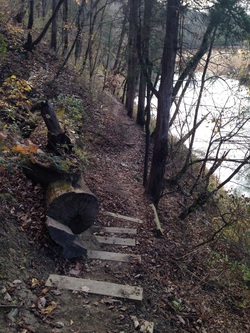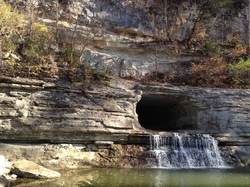The Narrows of Harpeth, a Historical Hike Outside Nashville
 The Narrows of Harpeth
The Narrows of Harpeth The 125 mile Harpeth River snakes its way through six counties in Middle Tennessee before it reaches its confluence with the Cumberland River on its way to the Mississippi. Parts of its 870-square-mile watershed comprise the Harpeth River State Park, which is known for its archeological sites and historic landmarks, in addition to its reputation as a popular canoe and kayak destination.
Geographically speaking, the Narrows of Harpeth is the most visually stunning and well-known section. The term “Narrows” refers to a point in the river where it circles back to within less than 200 feet of itself as its loops along a narrow wall of limestone.
This unusual natural feature inspired 19thcentury businessman Montgomery Bell to build an iron forge, blasting a 290 foot long tunnel, that was 8 feet high and 15 feet wide though the limestone ridge, thus diverting the water for power. Known at the time as the first full-scale water diversion tunnel, the Montgomery Bell Tunnel was considered a revolutionary engineering masterpiece. Because of the world-class steel that was produced at the Pattinson Forge, Bell earned the almost ominous moniker: The Iron Master of Harpeth.
Geographically speaking, the Narrows of Harpeth is the most visually stunning and well-known section. The term “Narrows” refers to a point in the river where it circles back to within less than 200 feet of itself as its loops along a narrow wall of limestone.
This unusual natural feature inspired 19thcentury businessman Montgomery Bell to build an iron forge, blasting a 290 foot long tunnel, that was 8 feet high and 15 feet wide though the limestone ridge, thus diverting the water for power. Known at the time as the first full-scale water diversion tunnel, the Montgomery Bell Tunnel was considered a revolutionary engineering masterpiece. Because of the world-class steel that was produced at the Pattinson Forge, Bell earned the almost ominous moniker: The Iron Master of Harpeth.
 The Montgomery Bell Tunnel
The Montgomery Bell Tunnel Today, the tunnel is the only remnant of Bell’s forge, and is now the site of a roughly 2-mile out-and-back that actually consists of three separate trails converging on a single trailhead. To the right is a scenic wooded trail that runs congruent with the northeastern section of the narrows, and even offers a small, albeit out of the way cave for those willing to climb a short, but very steep limestone encrusted hill.
The other two trails are both to the left, although, at differing elevations. The descendent trail leads to the remains of the Montgomery Bell Tunnel, while the ascendant is a steep climb to the top of the limestone ridge that offers a striking panoramic of the Harpeth River Valley, which was the etymological inspiration to the 1968 hit song “Harper Valley PTA,” written by Tom T. Hall.
In addition to the Narrows, the Harpeth River State Park is comprised of nine other unconnected access points
along the river. While most are simply access ramps for canoeist and kayakers, there are additional trails located at the Hidden Lakes, Newsom’s Mill and Mound Bottom sections. The latter is a Native American archeological site that was inhabited as early as 800 AD, during the Mississippian period. The prehistoric site, which is a complex burial mounds and living quarters, is only accessible by a ranger-led tour.
The other two trails are both to the left, although, at differing elevations. The descendent trail leads to the remains of the Montgomery Bell Tunnel, while the ascendant is a steep climb to the top of the limestone ridge that offers a striking panoramic of the Harpeth River Valley, which was the etymological inspiration to the 1968 hit song “Harper Valley PTA,” written by Tom T. Hall.
In addition to the Narrows, the Harpeth River State Park is comprised of nine other unconnected access points
along the river. While most are simply access ramps for canoeist and kayakers, there are additional trails located at the Hidden Lakes, Newsom’s Mill and Mound Bottom sections. The latter is a Native American archeological site that was inhabited as early as 800 AD, during the Mississippian period. The prehistoric site, which is a complex burial mounds and living quarters, is only accessible by a ranger-led tour.
 RSS Feed
RSS Feed